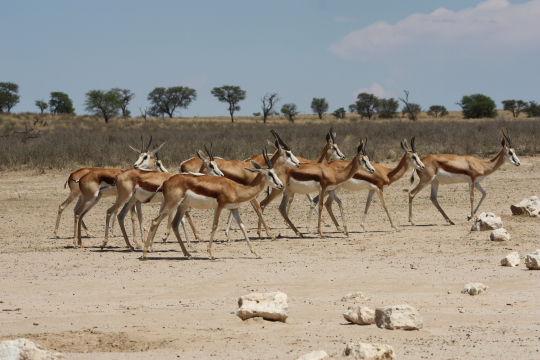In three separate research briefs EPRU Research Fellow, Johane Dikgang and Senior Research Fellow, Edwin Muchapondwa, analyze the situation in the Kgalagadi Transfrontier Park (KTP) extending between Botswana and South Africa.
Now that some of the resource rights inside KTP have been vested in the surrounding communities, the park should contribute toward improving the lives of these communities, so that land restitution and conservation objectives can reinforce each other. In this spirit, one of the aims of this study was to estimate optimal conservation fees which should be charged at KTP to maximise revenue. Overall, the results suggest that there is sheer underselling of the recreational services offered by the South African parks system, which implies that there is room for improvement in the conservation fee policy. Revenue could be maximised by increasing conservation fees for domestic tourists at KTP as well as other parks with little effect on visitation.
Visitors to KTP, located between Botswana and South Africa, are concerned about the kind of activities that take place within the park. This is not surprising, given the highly fragile Kgalagadi ecosystem. In this study, visitors were asked about their monetary valuation of pristine tourism opportunities at KTP. The researchers reasoned that, if this monetary value was greater than the value that local communities assign to their livelihood activities in the park, then one group could compensate the other. The results of this study showed that visitors want more recreational zones, which entails preventing local communities from extensive use of environmental resources in the area. The results also indicated that significant benefits could be obtained from a program aimed at imposing resource use restrictions inside the park, charging higher fees to visitors, and compensating local people for refraining from activities that 'degrade' the park ecosystem.
Furthermore, the results showed that a preservation initiative that is aimed at increasing grazing and hunting opportunities would be supported by the dryland communities. Although the Khomani San are traditionally hunters and gatherers, over time a significant number have switched to livestock farming. Given that livestock farming is one of the main livelihood sources in the Kgalagadi area, the Khomani San place a value on the ecosystem services that support it. Howver, the willingness of local people to pay to preserve the services they depend on was lower, in monetary terms, than the willingness to pay of park visitors to see the features of the ecosystem that attract tourists. That means the visitors can, in principle, be asked to pay more conservation fees in order to support the livelihoods of the local communities as compensation for their role in conservation in the Kgalagadi area.
To read these research briefs

